Viburnum leaf
beetle home
Back to How to identify viburnum leaf beetles
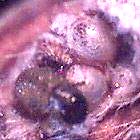
Watch larva hatching from egg
[1.4 MB .avi video by D. Swaciak. Need help?]
Logo images by Kent Loeffler, Paul Weston & Craig Cramer
|
When to look: Late April to mid-June
What to look for: When they first emerge from eggs, larvae are about 1 mm long, greenish-yellow to off-white, and lack spots.
Larvae go through three instars (stages), shedding their cuticle ("skin") between each. Second- and third-instar larvae are yellowish-brown with black spots along their backs, and grow up to 10 to 11 mm (about one-half inch).
Where to look: Anywhere on leaves, usually the underside when the larvae are young, and usually more than one larvae on a leaf.
They are hard to spot early on, so look for them on leaves near empty egg-laying sites.
As they get older, they feed more on the tops of the leaves, and like the adults they are more prone to dropping off if disturbed.
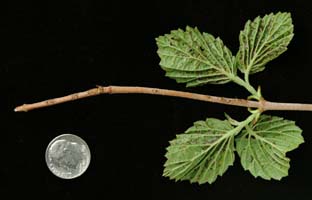
Larger image. Photo by Kent Loeffler
Early on, larvae are hard to spot. Sometimes it helps to look for dead twig tips, such as on this arrowwood (Viburnum dentatum). The egg sites are located on the portion of the twig that died. After hatching, the larvae moved down to the newly emerging leaves.
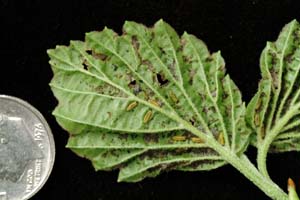
Larger image Photo by Kent Loeffler
Look carefully to spot young larvae feeding between the veins on young leaves.
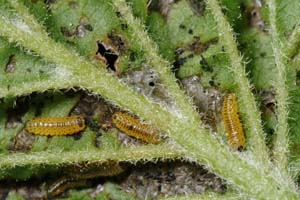
Larger image. Photo by Kent Loeffler
With a hand lens or magnifying glass, you can easily see the young larvae feeding.
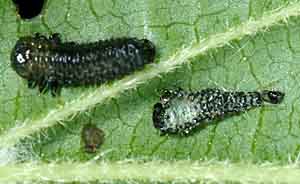
Larger image. Photo by Kent Loeffler
Larvae shed their cuticle (insect skin) as they grow. Note the old cuticle on right.
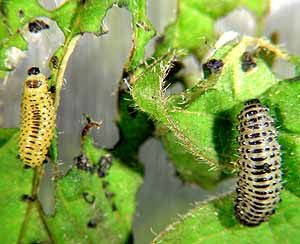
Larger image Photo by Paul Weston
Second instar larvae (left) are yellowish with black spots. Third instar larvae (right) are darker, and grow up to 10 to 11 mm (about one-half inch) before crawl down the plant to pupate in the soil.
© Copyright, Department of Horticulture, Cornell University.
Project coordinator: Lori Brewer, ljb7@cornell.edu
Website design: Craig Cramer cdc25@cornell.edu
Mention of trade names and commercial products is for educational purposes; no discrimination is intended and no endorsement by Cornell Cooperative Extension or Cornell University is implied. Pesticide recommendations are for informational purposes only and manufacturers' recommendations change. Read the manufacturers' instructions carefully before use. Cornell Cooperative Extension and Cornell University assumes no responsibility for the use of any pesticide or chemicals. Some of the links provided are not maintained by Cornell Cooperative Extension and Cornell University. Cornell Cooperative Extension and Cornell University are not responsible for information on these websites. They are included for information purposes only and no endorsement by Cornell Cooperative Extension or Cornell University is implied. Cornell Cooperative Extension provides equal program and employment opportunities.
|